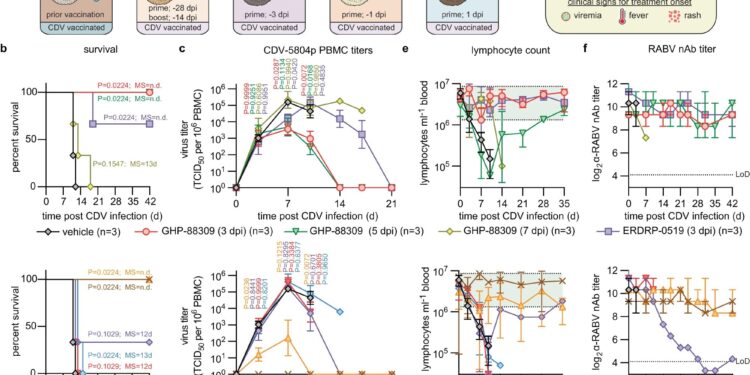Therapeutic treatment of fatal CDV infection in ferrets. Ferrets were infected with a lethal CDV challenge and treated with GHP-88309, ERDRP-0519, or therapeutic vaccination. A Outline of study design. Ferrets were infected with wild-type recCDV-5804p and monitored for 6 weeks. The symbols in the different boxes show the clinical presentation of the animals when the treatment of the respective group was initiated. b Survival curves of infected ferrets in (A). log-rank test (Mantel-Cox), median survival is indicated. vs Viremia titers associated with PBMCs from CDV-infected ferrets shown in (A). Two-way ANOVA with Dunnett’s post hoc test. d Images of ferrets taken 12 days after recCDV-5804p infection. e Number of lymphocytes from infected ferrets measured during the duration of the study detailed in (A). Green shading indicates normal range. F RABV neutralizing antibody titers from CDV-infected ferrets. Symbols (vs, e, F) represent geometric means ± geometric SD, lines intersect means. In (b–e), the top row shows the results for the inhibitor-treated groups, the bottom row for vaccinated animals; LoD, limit of detection; not = 3. Source data is provided as a source data file. Credit: Natural communications(2024). DOI: 10.1038/s41467-024-45418-5
Infection with a measles-like virus causes catastrophic lung failure in ferrets previously infected with influenza virus or respiratory syncytial virus, according to a study led by researchers at the Georgia State University Translational Antiviral Research Center .
In the study published in Natural communications , researchers studied ferrets infected with a common respiratory virus such as respiratory syncytial virus or influenza virus, which causes flu-like illness in animals. A month after their full recovery, the animals were injected with a non-lethal strain of canine distemper virus (CDV), which is closely related to the human measles virus and which causes measles-like illness in ferrets. Two weeks later, the animals developed fatal hemorrhagic pneumonia.
“Acute lung failure after consecutive infection with two non-fatal respiratory viruses was unprecedented,” said study senior author Richard Plemper, Regents Professor at the Georgia State Institute for Biomedical Sciences and director from the Center for Translational Antiviral Research. “We found that these animals did not succumb to the viral infection, but to bacterial pneumonia because they became unable to prevent invasion of the lungs by commensal bacteria.”
By looking for differences in gene expression between animals infected or not with influenza virus, the study found that distemper infection results in the expression of a group of host-protective proteins in the lungs called trefoil factors.
“When the animals recovered from the flu, the clover factors were not upregulated, leaving them without protection against normally harmless bacteria,” said Robert Cox, assistant professor in the Center for Translational Antiviral Research and first author of the study. “Usually these animals recovered, but when exposed to CDV, this decrease in levels of protective host proteins led to the development of severe bacterial pneumonia.”
Using an experimental antiviral drug, GHP-88309, that Plemper developed in recent work, they were able to prevent fatal bacterial pneumonia even when treatment began very late after CDV infection.
“We do not currently know whether the measles virus causes worsening of disease following previous unrelated viral infections, but this adds greatly to the concerns about the resurgence of measles that we have seen in recent years around the world. ” said Plemper. “Measles is frequently followed by bacterial otitis media or bacterial pneumonia. A child’s history of viral illness may be an underestimated risk factor for developing these secondary sequelae.”
“In addition to discovering that previous infections may play a crucial role in disease severity, we were able to experimentally identify the window of opportunity to treat these viral infections and prevent the long-term immune suppression associated with measles-like illnesses “Cox said. .
The researchers demonstrated the benefits of treatment with GHP-88309 for more than seven days after the therapeutic vaccination window closed, “which introduces an additional new option to mitigate serious complications of measles-like illness,” said Cry.
More information:
Robert M. Cox et al, Therapeutic mitigation of measles-like immune amnesia and exacerbated disease after prior respiratory viral infections in ferrets, Natural communications(2024). DOI: 10.1038/s41467-024-45418-5
Provided by Georgia State University
Quote: Serious lung damage caused when influenza is followed by infection with a measles-like virus, study finds (February 8, 2024) retrieved February 8, 2024 from
This document is subject to copyright. Apart from fair use for private study or research purposes, no part may be reproduced without written permission. The content is provided for information only.



